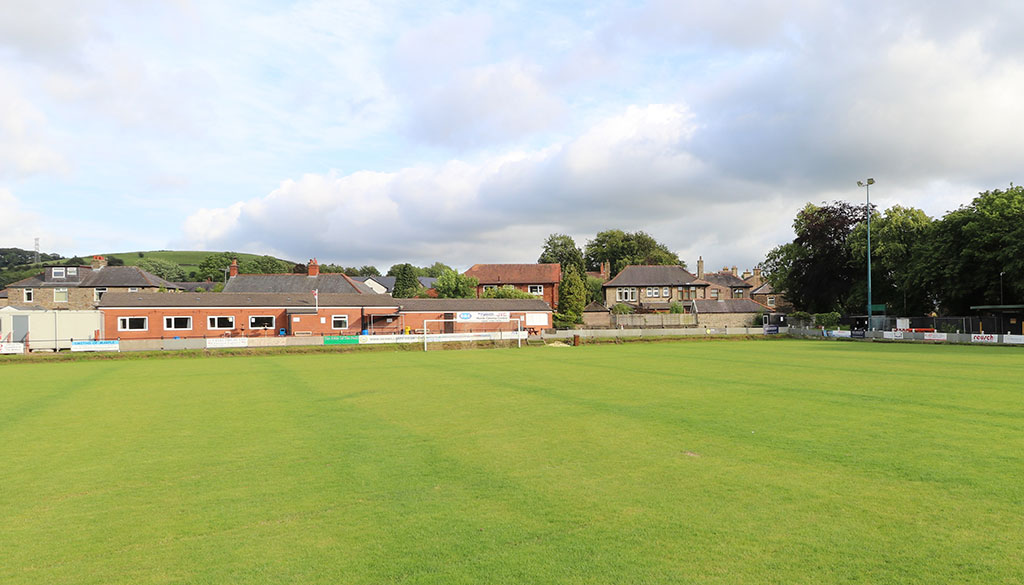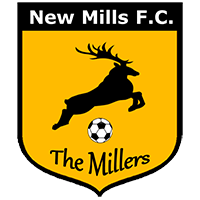
Emblematically Speaking - New Mills
Tue 13th February 2018 | New Mills | By Stewart Taylor
The origins of the New Mills AFC club emblem are not known, although there are a few references which can be brought to bear.
If we start prior to the now infamous Local Government Reorganisation Act of 1972, we discover that New Mills was an Urban District Council.
In local government terms now, whilst a part of the High Peak, it has a Town Council and the devices shown on the current football club emblem are derived from the Town Council badge.
The New Mills Town Council Badge was in use by the football club prior to the adoption of the current emblem. In the football club archives are letters from the 1950s, which include the Town Badge to confirm this point..
From that, we could speculate that the current football club emblem came into use sometime after the 1950s although exactly when is not known.
The Town Council badge is in the form of a shield and shows a stag as the main focus, beyond which is a representation of a bridge and a topographical feature indicating a valley.
Reference to the current emblem shows a repeat of thes devices but in a roundel form with the addition of a clear reference to the purpose of the club – football – and the name of the club. Around the edge of the roundel we see the name of the club repeated along with the nickname “The Millers”.
If we look at each of these devices in turn, we can see that they go quite a way to representing the town of New Mills but, unusually, show no specific references to the industrial aspect of the town.
The term “Hills and Mills” has occasionally been used as a sort of shorthand description of the town and the surrounding area, thus giving a clear reference to the industry which, to some extent, defined the town and the reason why it developed.
As those who have visited the Church Lane ground will know, this is a picturesque area and, from the ground, the high point of the High Peak, Kinder Scout, can be seen. This suggests that we are indeed in an area of hills and valleys and that is represented in the emblem by the background of brown hills and a valley against a blue sky.
Of great relevance to the town in terms of valleys, and the watercourses which formed them, is The Torrs. This is a steep sided gorge formed as the River Sett approaches its confluence with the River Goyt.
Where we have valleys we see bridges, and there are many bridges in New Mills and the surrounding area. The most significant, practically, is that which crosses the Torrs and is known as the Union (High Level) Bridge.
This bridge was opened in 1884 and forms the link for vehicles and pedestrians between New Mills and what we now know as New Mills Newtown.
Scholars of the UK railway network will be aware that there are two railway stations in New Mills which is unusual in such a small town, but indicative that New Mills (Derbyshire) and Newtown (Cheshire) had their own identities.
New Mills Central station opened in 1865, New Mills Newtown station opened in 1857 and are stops on different railway lines. This pre-dates the opening of the Union Bridge.
But, having said all of that about Union Bridge, it is made of stone and, important that the bridge is, bears little resemblance to the structure depicted in the emblem. It is perhaps more likely that this refers to an ancient bridge which crossed the River Sett close to Salem Mill.
The final device to consider is the stag and to understand the significance of this we need to go back several centuries. Long before the industrialisation of the area the landscape was dominated by forest, specifically, a Royal Forest.
The Royal Forest covered some 180 square miles and it is recorded that King Henry II hunted stag, and other wild animals, in the forest in the middle years of the 12th century.
The area was offically deforested during the reign of King Charles II.
Much of the above is speculation, as we can find nothing definitive relating to the development of the club emblem to what we see today. What we have done is taken what we can see and tried to relate that to what is known of the history of New Mills which, to be fair, is rather a lot.
If anyone reading this knows more about the development of the club emblem or, equally, the background to the devices displayed on the New Mills Town badge, then please let us know and, who knows, we might be able to add to the readily accessible knowledge on the subject of the New Mills AFC emblem.
Our thanks to Allan Jones of New Mills AFC for his help in compiling this article.
 Emblematically Speaking - New Mills
Emblematically Speaking - New Mills
Tue 13th February 2018 | New Mills
By Stewart Taylor

The origins of the New Mills AFC club emblem are not known, although there are a few references which can be brought to bear.
If we start prior to the now infamous Local Government Reorganisation Act of 1972, we discover that New Mills was an Urban District Council.
In local government terms now, whilst a part of the High Peak, it has a Town Council and the devices shown on the current football club emblem are derived from the Town Council badge.
The New Mills Town Council Badge was in use by the football club prior to the adoption of the current emblem. In the football club archives are letters from the 1950s, which include the Town Badge to confirm this point..
From that, we could speculate that the current football club emblem came into use sometime after the 1950s although exactly when is not known.
The Town Council badge is in the form of a shield and shows a stag as the main focus, beyond which is a representation of a bridge and a topographical feature indicating a valley.
Reference to the current emblem shows a repeat of thes devices but in a roundel form with the addition of a clear reference to the purpose of the club – football – and the name of the club. Around the edge of the roundel we see the name of the club repeated along with the nickname “The Millers”.
If we look at each of these devices in turn, we can see that they go quite a way to representing the town of New Mills but, unusually, show no specific references to the industrial aspect of the town.
The term “Hills and Mills” has occasionally been used as a sort of shorthand description of the town and the surrounding area, thus giving a clear reference to the industry which, to some extent, defined the town and the reason why it developed.
As those who have visited the Church Lane ground will know, this is a picturesque area and, from the ground, the high point of the High Peak, Kinder Scout, can be seen. This suggests that we are indeed in an area of hills and valleys and that is represented in the emblem by the background of brown hills and a valley against a blue sky.
Of great relevance to the town in terms of valleys, and the watercourses which formed them, is The Torrs. This is a steep sided gorge formed as the River Sett approaches its confluence with the River Goyt.
Where we have valleys we see bridges, and there are many bridges in New Mills and the surrounding area. The most significant, practically, is that which crosses the Torrs and is known as the Union (High Level) Bridge.
This bridge was opened in 1884 and forms the link for vehicles and pedestrians between New Mills and what we now know as New Mills Newtown.
Scholars of the UK railway network will be aware that there are two railway stations in New Mills which is unusual in such a small town, but indicative that New Mills (Derbyshire) and Newtown (Cheshire) had their own identities.
New Mills Central station opened in 1865, New Mills Newtown station opened in 1857 and are stops on different railway lines. This pre-dates the opening of the Union Bridge.
But, having said all of that about Union Bridge, it is made of stone and, important that the bridge is, bears little resemblance to the structure depicted in the emblem. It is perhaps more likely that this refers to an ancient bridge which crossed the River Sett close to Salem Mill.
The final device to consider is the stag and to understand the significance of this we need to go back several centuries. Long before the industrialisation of the area the landscape was dominated by forest, specifically, a Royal Forest.
The Royal Forest covered some 180 square miles and it is recorded that King Henry II hunted stag, and other wild animals, in the forest in the middle years of the 12th century.
The area was offically deforested during the reign of King Charles II.
Much of the above is speculation, as we can find nothing definitive relating to the development of the club emblem to what we see today. What we have done is taken what we can see and tried to relate that to what is known of the history of New Mills which, to be fair, is rather a lot.
If anyone reading this knows more about the development of the club emblem or, equally, the background to the devices displayed on the New Mills Town badge, then please let us know and, who knows, we might be able to add to the readily accessible knowledge on the subject of the New Mills AFC emblem.
Our thanks to Allan Jones of New Mills AFC for his help in compiling this article.


